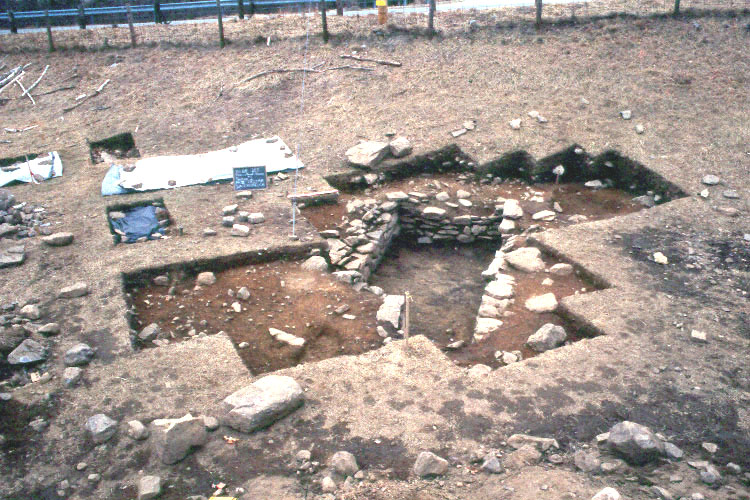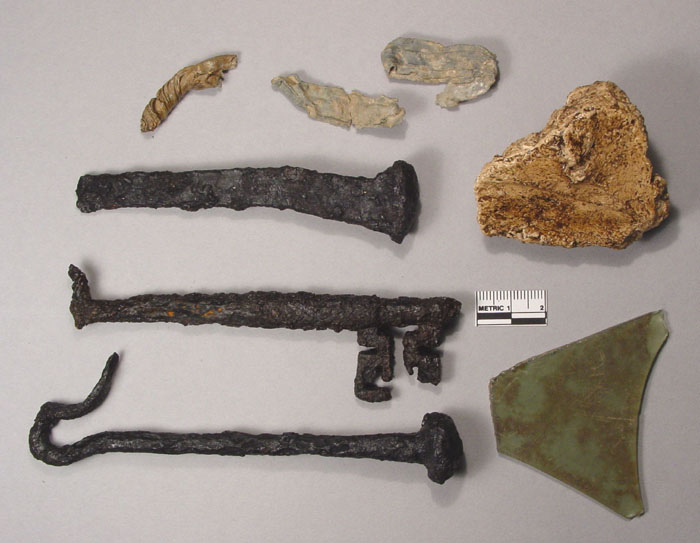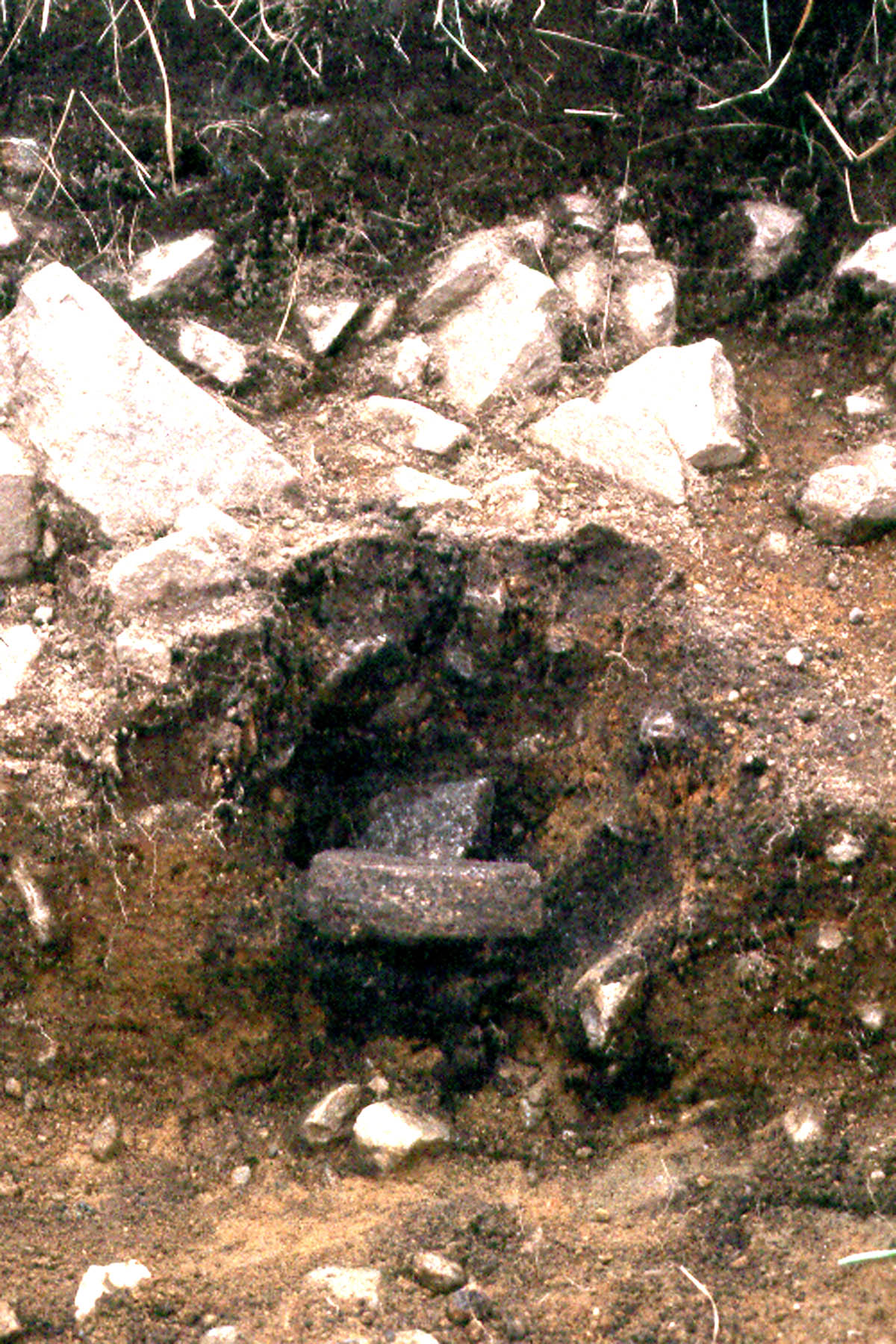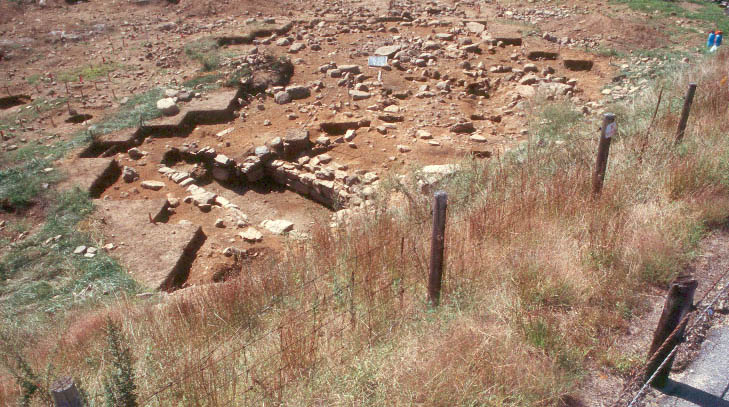
Image of the excavated cellar, with the camera facing north. North of the cellar is a road embankment built in the 1950s, which overlaid a 17th-century road. Click to enlarge.

|
|
Image of the excavated cellar, with the camera facing north. North of the cellar is a road embankment built in the 1950s, which overlaid a 17th-century road. Click to enlarge. |
The first feature discovered during the data recovery excavation was the stone-lined cellar of the house.
The cellar had been filled with stone and artifact-rich soil. The cellar hole measured 16 x 18 feet and had a
south-facing exterior bulkhead entrance. There were no stairs in the bulkhead; they were probably made of wood and
rotted away long ago. The cellar’s dirt floor was found 3 feet 9 1/2 inches below the ground surface. At the
northern end of the floor was a six-inch-deep trough which served as a sump to collect rain or ground water seepage.
This was important because water could ruin the food colonial families stored in their cellars.

|
|
Three pieces of lead window came, an iron spike, an iron key, and an iron hook to a trammel. On the right are a fragment of shell mortar and green window glass. Click to enlarge. |
Eight feet northwest of the cellar was a fireplace feature about 4 feet in diameter. Only parts of the fireplace base remained, consisting of one to two courses of flat stacked stone. The remainder of the fireplace stonework, including the chimney stack, was disassembled after the house was abandoned. Some of the stones were tossed in the cellar hole when it was filled and others were evidently carried away for reuse elsewhere. Around the fireplace were many fragments of mortar made from shellfish; ground-up shellfish and coral were burned to make lime, which was mixed with water and sand to form the mortar. Connecticut has few limestone deposits and early colonial builders often used shell mortar in stonework.
A few red brick fragments from the site suggest that the chimney stack was only bricked above the roof-line, to give the appearance of a more expensive chimney and brick fireplace. The presence of green and blue-green window glass and lead window came indicate the house had leaded casement windows.
The original house built by Thomas Daniels in 1712 was a simple timber-framed one-over-one-room end-chimney type
which measured approximately 16 x 28 feet in plan. The house may have been a 1 ½-story or two stories in height. The first-floor room was commonly called the “hall”
and the room above it the “chamber.” The archaeologists found no foundation stones extending off the cellar walls, indicating that the house had
been built using foundation-on-ground construction; that is, the house sills stood on a stone “pad” which was laid
directly on the ground surface. After the house was abandoned and dismantled and its site converted into an
agricultural field, the pad stones were removed leaving no foundation walls in place other than the cellar walls.
The foundation walls are projected from the locations of the cellar hole and fireplace features, and by the
distribution of artifacts. The
distribution of nails from the site shows the locations of the south wall of the house
and the post-Daniels blacksmith shop/nailery.
The distribution of kaolin tobacco pipestems indicates that the eastern half of the house was built first, based on concentrations of 6/64th and 7/64th stems, which generally date to the 1650-1680 and 1680-1710 periods. The 5/64th pipestems, which generally date to 1710-1750, were found throughout the original house and post-in-ground addition, and are from the Daniels (1712-1744) and post-Daniels (1744-ca. 1770s) occupations. The 4/64th pipestems, which date to the general period of 1750 to 1800, were predominately found around the post-in-ground addition. In the cellar hole were pipestems from all periods, because the soil that was used to fill the cellar after the house was abandoned was taken from around the house, where the house occupants had deposited their trash for most of the 18th century. Household refuse was commonly tossed out of windows and doors in Colonial times, so the distribution of the pipestems around the house reveals where the house walls had been, even though the foundation stones had been removed.

|
|
Feature 3, a typical post hole, showing shim stones. |
The discovery of 27 post holes revealed that a post-in-ground or earthfast addition had been built off the western end of the house. Concentrations of creamware (1762-1820) and Jackfield (1745-1790) ceramics in and around the post holes indicated that the earthfast addition was built by the unidentified people who lived in the house after Hannah Daniels died in 1744. The post holes averaged eight to ten inches in diameter and extended from several inches to 18 inches in depth. There were likely more posts associated with the earthfast addition than observed in the excavation, but some were obliterated by repeated plowing. The posts for the earthfast addition were likely of the puncheon post variety, which simply involved driving the posts in the ground or setting them in augured holes. The clapboards were then nailed directly to the upright posts which had been planed flat on the outside. Some of the post holes contain shim stones, wedged in the bottom and sides of the post holes to stabilize the posts. The post-in-ground addition measured approximately 16 x 19 feet, which made a somewhat offset basic two-room central-chimney house plan measuring approximately 47 x 16 feet in size. To supplement the photographs of the post holes, drawings were also prepared.
There were likely more posts associated with the earthfast addition than observed in the excavation, but some were
obliterated by repeated plowing. The posts for the earthfast addition were likely of the puncheon post variety,
which simply involved driving the posts in the ground or setting them in augured holes. The clapboards were then
nailed directly to the upright posts which had been planed flat on the outside. Some of the post holes contain
shim stones, wedged in the bottom and sides of the post holes to stabilize the posts. The post-in-ground addition
measured approximately 16 x 19 feet, which made a somewhat offset basic two-room central-chimney house plan
measuring approximately 47 x 16 feet in size.

|
|
An overview photograph of the site taken from the road embankment. The cellar hole is in the foreground. The camera is facing southwest. Click to enlarge. |
Within the earthfast addition was an oval-shaped pit in the floor measuring 9 feet 10 inches x 5 feet 3 inches. The basin-shaped western side of the pit was considerably deeper, and was 2 feet 6 inches below the ground surface. The pit was probably used for food storage. Off the back of the earthfast addition was a post-in-ground lean-to that covered a small blacksmith shop, which primarily manufactured nails.
The one-room end-chimney type house was one of the most common house forms built in 17th- and 18th-century Connecticut, when houses were much smaller than they are today. As families grew in size and became established, another room was often added to the hall, making a typical hall-and-parlor center-chimney house. Some hall-and-parlor houses were expanded with a lean-to addition attached across the back of the house, which functioned as a kitchen and pantry. This house form has come to be called a “saltbox” house, because the shape resembles a container that held salt. Among the very few standing houses in Connecticut that began as a simple one-room end-chimney type are the 1664 Thomas Lee House in East Lyme, the ca. 1678 Hempstead House in New London, and the ca. 1723 Huntington House in Scotland [the birthplace of Governor Samuel Huntington]. All of these house forms originated in England and were brought to America by the colonists, where these building traditions continued for generations.
Although the Daniels House appears to be the first archaeological evidence of earthfast construction in Connecticut, the building technique itself may not have been uncommon. While traveling from Boston to New York in 1704, Sarah Knight recorded an intriguing observation in her diary. During her brief stay with a family on the east bank of the Pawcatuck River (the border between Connecticut and Rhode Island), just 20 miles from the Daniels House, Madam Knight described the house:
It was suported with shores enclosed with clapbords, laid on Lengthways, and so much asunder, that the Light come throu’ every where; the doore tyed on with a cord in the ye place of hinges; The floor the bear earth; no windows but such as the thin covering afforded, nor any furniture but a Bedd with a glass Bottle hanging at the ead on’t; an earthan cupp, a small pewter bason. . . (Knight 1825:23-24).
Madam Knight’s description of the walls “suported with shores enclosed with clapbords;” that is, upright posts with clapboards nailed on, seems analogous to the Daniels House post-in-ground addition.